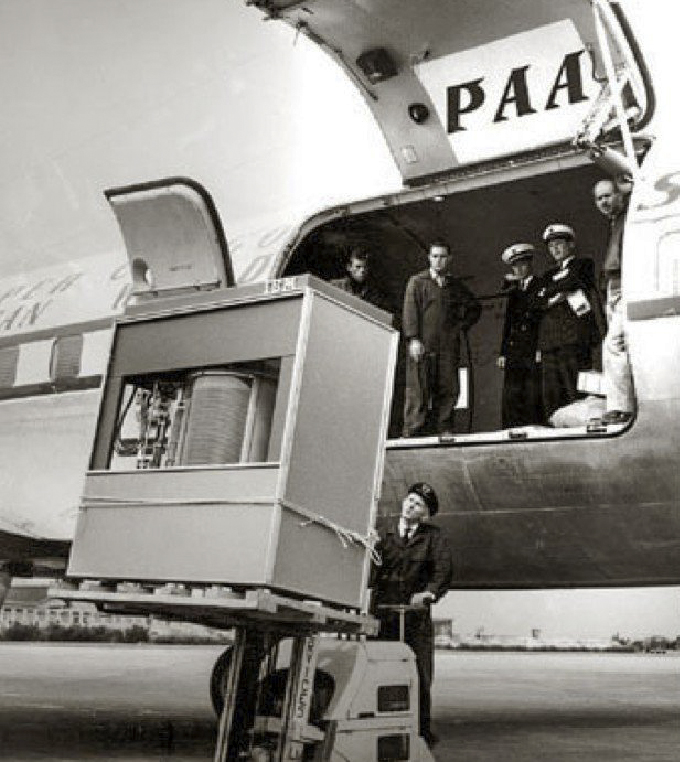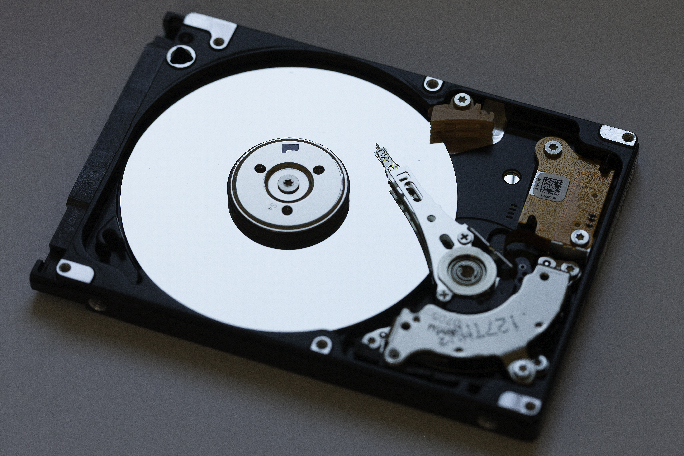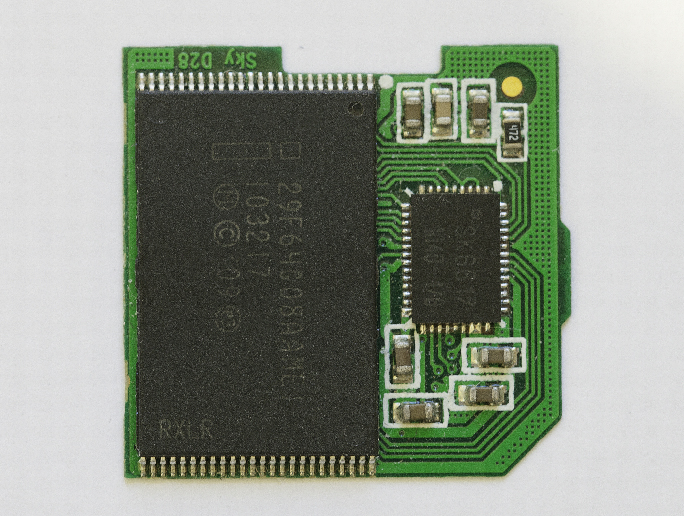I got an e-mail from a friend with a link to a Facebook page where a photo was displayed of an IBM hard drive was being loaded onto an Pan American airliner with a forklift. The disk, according to the page, was capable to storing 3.75 megabytes after formatting. That’s:
3,750,000 bytes of data
This is the IBM hard drive being lifted to the waiting cargo hold of a Pan Am plane.
And, the story continued that this is about the size of one photo on an iPhone. What the article didn’t say is that the photo size on the iPhone is the compressed size in JPEG. Uncompressed, the images from the iPhone are 24 megabytes in size. That’s:
24,000,000 bytes of data
…which is about six times the capacity of that IBM drive.
I was amused by the size of the drive, and was momentarily nostalgic about the first big hard drive I ever bought (nowhere as large as the one in the photo). It was a 10 MB drive, with 7.8 MB of storage after formatting. It had a single platter 14 inches in diameter, a drive motor that was listed as having 1/10 HP, and an automotive V-belt to transfer power from the motor to the platter hub.
The drive came in a cabinet that weighed about 80 lbs. It took two to carry it using the built-in handles.
This drive cost about $10,000, and the company from which I purchased it – Mergenthaler Linotype – strongly suggested that having just one of these drives was very risky, and that I should really purchase two, so that I could use one to back the other up. So I did. These “massive” storage devices held text for our two typesetting machines, the Mergenthaler VIP and, later, the Mergenthaler 202W, which was a cathode-ray-tube typesetter. Both were extraordinary machines.
I remember the scariest thing about the 10 MB drives was the process of “optimizing” a drive. This was effectively de-fragmenting the drive’s contents. During this process, data was sequentially read from a sector, then re-written to a new sector on the drive, compacting the sectors to make the drive more efficient, and to remove wasted sectors that were left behind when files were erased.
During the optimizing process the data was stored in memory, of which there was scant little. And, if the drive failed during the optimizing process, we were out in the cold, as all of the data on the drive would then be corrupt. That was why I felt better about having the second drive, which was a mirror of the first. Whenever we optimized one drive, we would then test it thoroughly, and then optimize the other. It was a risky business, but it worked, and we were grateful not to have to use paper punch tape, which was the storage technology we used prior to having the “big” hard drives.
A couple of years later, my friend Tom and I built an electronic box that connected an Apple IIe computer to the V-I-P’s paper tape reader with a long, fat cable. With a little work we were able to use the Apple computer to mimic paper tape by signaling the receiving photosensors the same signals that a paper tape would have, and it allowed us to use the Apple Writer II word processor as our text editor instead of the AKI paper tape keyboards we had been using.
The benefits were many, chief among them the ability to edit an entire document on the screen of the computer, then to send the text to the typesetter, and have it generate typesetting on photo paper or film in its usual way. This was very clever in hindsight. We stopped using the “big” hard drives and we started using 5.25 inch floppy disks on the Apple IIe. Soon we had several Apple II computers running all of our typesetting work, and they were by far more efficient and reliable.
Floppy disks were cheap enough that we could write a customer’s job on one, then put it into the job ticket envelope for storage. If the client returned for corrections, we could easily retrieve the disk, put it back into the Apple computer, and edit it. We could save numerous versions of jobs on one disk and have room to spare.
And, as time passed, we bought a Macintosh, and a Linotronic 300, and we became one of the first typesetting companies in the United States to offer PostScript output for those early adopters of “desktop publishing.” We accepted floppies from customers all over the country, and we ran their jobs to film, and shipped them off in the mail, or when a deadline was really tight, we used the Greyhound Bus, the depot being just one block away from our shop. On very rare occasions, we took a package to the airport and paid for it to be shipped by “air express” on our small local airline. When it arrived in Los Angeles – about an hour away – it was retrieved by a courier, and then delivered to the client.
Storage systems got bigger, and over time we saw internal hard drives grow in capacity from 10 MB to 20 MB then on to 100 MB and more. They got lighter thinner and more capacious.
This last week I had a new 500 GB hard drive installed in an old Mac Mini computer. The installation and the labor came to about $100. 500 GB is:
500,000,000,000 bytes of data
This is the 60 GB hard drive that had failed in my Mac Mini. Now it’s a curiosity for my students who will hand it around in class.
That’s 1.3 BILLION times more data than the hard drive depicted in the photo. (Don’t you love comparisons like this?)
The irony is that the 500 GB drive is the smallest drive available in the format that fits into the Mac Mini.
The drive that was replaced was a whopping 60 GB drive. When I got home I took the cover off of it – voiding the warranty – and took some photos of the splendor of its workings. What amazing technology is found inside one of these things!
The I started thinking about storage, and trends in storage. On my desk was a slightly damaged SD memory card, one with 32 GB of capacity. I cracked the plastic case off of it, and took some photos. There, on a circuit board about the thickness of a postcard, is a single chip with 853 MILLION times the capacity of the IBM hard drive show in the photo. This stuff is amazing!
This is the circuit that I broke out of the SD memory card from my digital camera. This one contains 853 million times the capacity of the IBM drive in the top photo.
And, unlike me, these storage devices don’t forget stuff.
I aspire to be so efficient!




